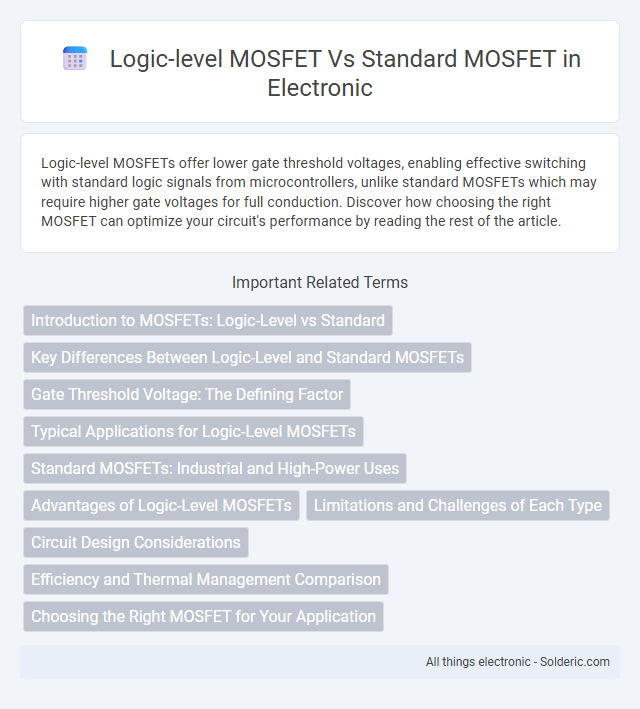Logic-level MOSFETs offer lower gate threshold voltages, enabling effective switching with standard logic signals from microcontrollers, unlike standard MOSFETs which may require higher gate voltages for full conduction. Discover how choosing the right MOSFET can optimize your circuit's performance by reading the rest of the article.
Comparison Table
| Feature | Logic-level MOSFET | Standard MOSFET |
|---|---|---|
| Gate Threshold Voltage (VGS(th)) | Low (~1-2V) for direct drive by logic signals | Higher (~2-4V), requires higher gate drive voltage |
| Application | Digital circuits, microcontroller interfaces, low-voltage switching | Power amplification, switching in higher voltage environments |
| Gate Drive Requirement | Compatible with 3.3V or 5V logic levels | Often needs 10-12V gate drive for full enhancement |
| On-Resistance (RDS(on)) | Low at logic-level gate voltage | Low only at higher gate voltages |
| Switching Speed | Fast switching suited for digital signals | Varies; typically optimized for power applications |
| Cost | Generally higher due to specialized design | Typically lower cost, widely available |
| Examples | IRLZ44N, IRLB8721 | IRF540N, IRFZ44N |
Introduction to MOSFETs: Logic-Level vs Standard
Logic-level MOSFETs are designed to fully switch on at lower gate voltages, typically around 4.5V or less, making them ideal for direct interfacing with microcontrollers and low-voltage digital circuits. Standard MOSFETs usually require higher gate voltages, around 10V, to achieve optimal conduction, which may necessitate additional driver circuitry. Choosing the appropriate MOSFET type ensures efficient performance and reliable operation in your electronic designs.
Key Differences Between Logic-Level and Standard MOSFETs
Logic-level MOSFETs feature a lower gate threshold voltage, typically around 1-2V, enabling full enhancement with standard logic signals from microcontrollers operating at 3.3V or 5V. Standard MOSFETs generally require higher gate voltages, often 10V or more, for optimal conduction, making them less suitable for low-voltage digital circuits. The on-resistance (R_DS(on)) of logic-level MOSFETs is optimized for low voltage drive, ensuring efficient switching in battery-powered and low-voltage applications where energy efficiency is critical.
Gate Threshold Voltage: The Defining Factor
Logic-level MOSFETs feature a significantly lower gate threshold voltage, typically around 1 to 2 volts, enabling them to fully turn on with standard logic-level signals from microcontrollers and digital circuits. In contrast, standard MOSFETs usually require a higher gate threshold voltage of 2 to 4 volts, making them less suitable for direct interfacing with low-voltage logic devices. This difference in gate threshold voltage is crucial for optimizing switching efficiency and minimizing power loss in low-voltage applications.
Typical Applications for Logic-Level MOSFETs
Logic-level MOSFETs are ideal for low-voltage switching applications where microcontroller or digital logic signals drive the gate, such as battery-powered devices, motor controllers, and power management circuits. Their lower gate threshold voltage enables efficient operation directly from 3.3V or 5V logic levels, enhancing performance in embedded systems and portable electronics. Your design can benefit from improved switching speed and reduced power loss compared to standard MOSFETs in these scenarios.
Standard MOSFETs: Industrial and High-Power Uses
Standard MOSFETs are widely used in industrial and high-power applications due to their ability to handle higher voltage and current levels with robust thermal performance. These devices typically feature higher threshold voltages and larger die sizes, making them ideal for power conversion, motor control, and switching regulators in heavy-duty environments. Their design optimizes efficiency and durability under demanding electrical and thermal stress conditions, distinguishing them from logic-level MOSFETs optimized for low-voltage gate drive compatibility.
Advantages of Logic-Level MOSFETs
Logic-level MOSFETs offer lower gate threshold voltages, allowing them to fully switch on at standard logic voltages such as 5V or 3.3V, which enhances compatibility with microcontrollers and digital circuits. These MOSFETs typically exhibit reduced on-resistance (R_DS(on)), leading to improved efficiency and minimal power dissipation in low-voltage applications. Their faster switching speeds and better thermal performance make logic-level MOSFETs ideal for battery-powered and compact electronic designs.
Limitations and Challenges of Each Type
Logic-level MOSFETs face limitations such as lower voltage ratings and higher on-resistance, which can restrict their use in high-power applications. Standard MOSFETs often require higher gate voltages to turn on fully, posing challenges in low-voltage control circuits and increasing switching losses. Understanding these constraints helps you select the right MOSFET type for efficient and reliable circuit performance.
Circuit Design Considerations
Logic-level MOSFETs require lower gate voltages, typically around 4.5V or less, making them ideal for low-voltage control circuits and microcontroller interfaces. In contrast, standard MOSFETs usually need higher gate drive voltages (10V or more) to achieve full conduction, impacting power efficiency and switching speed in your circuit design. Selecting the appropriate MOSFET depends on your logic voltage availability and load requirements to optimize performance and reliability.
Efficiency and Thermal Management Comparison
Logic-level MOSFETs exhibit lower on-resistance (R_DS(on)) at gate voltages of 4.5V or lower, enhancing efficiency by reducing conduction losses in low-voltage control circuits compared to standard MOSFETs. Their optimized gate thresholds enable faster switching speeds and lower gate charge, which minimizes switching losses and improves thermal performance under dynamic loads. This efficiency translates to reduced heat generation and simplified thermal management, making logic-level MOSFETs ideal for power-sensitive applications with stringent thermal constraints.
Choosing the Right MOSFET for Your Application
Logic-level MOSFETs feature a lower gate threshold voltage, enabling full enhancement with standard microcontroller logic signals (typically 5V or 3.3V), making them ideal for low-voltage control applications. Standard MOSFETs require higher gate voltages (often 10V or more) for optimal conduction, thus they are better suited for power supply circuits or systems with dedicated gate drivers. Selecting the right MOSFET depends on the driving voltage available and the load current requirements to ensure efficient switching and minimize power loss.
Logic-level MOSFET vs Standard MOSFET Infographic

 solderic.com
solderic.com